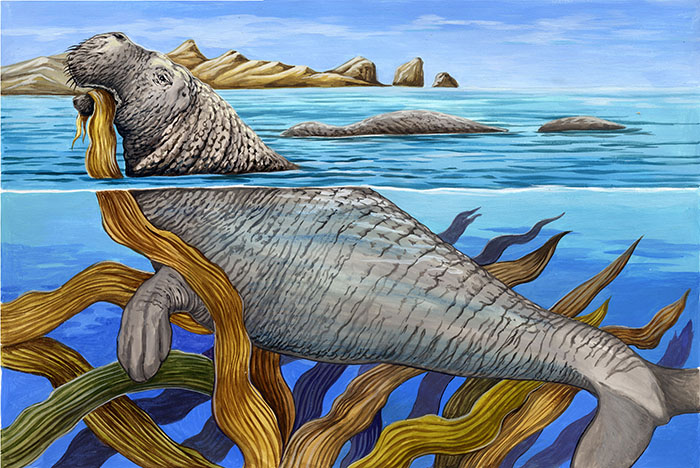Imagine sitting high on a cliff and looking down through the clear water to watch these huge animals slowly rolling around in a kelp bed below! I wonder whether we would have seen nursing calves, or sleeping adults? Could we have heard their sighs and snorts?

Tragically, we’ll never be able to see the Steller’s Sea Cow (Hydrodamalis gigas), but their story of discovery and extinction is a powerful lesson in conservation and the importance of understanding ecological complexity.
The Commander Islands in Russia are the westernmost islands in the long Aleutian Island Archipelago, and the largest Island (Bering Island) was named after Commander Vitus Bering who was shipwrecked there in 1741. Georg Wilhelm Steller was on this expedition, and was the first scientist to describe the sea cow. Steller and the crew of the St. Peter were shipwrecked on Bering Island for a year, and Commander Vitus Bering and 28 of his crew died of scurvy. Despite the inconceivable hardship experienced during this year, Steller was able to spend a lot of time researching and learning about the local animals. Much of what is known about the behavior of sea cows comes from Steller’s observations on the Commander Islands during this epic year, and he even described drinking the sea cow fat in cups, and it tasting like almond oil.
The sea cow was only found around the Commander Islands during the time of Steller’s study, but researchers believe its’ range used to extend across the Pacific during the Pleistocene era. These amazing marine animals were enormous, with adult body lengths up to 9 meters, and they likely weighed 4-5 tons. As a comparison, African elephant males weigh between 2-7 tons! Their tail was forked like whales or dugongs, and they had no teeth. They chewed kelp using 2 keratinous plates. They communicated with sighs and snorts and Steller believed they were social animals, living in small family groups. Unlike the dugongs and manatees that are alive today, the sea cow was unable to submerge completely.
There may have been only about 2000 individuals remaining when described by Steller, and within 27 years the species was driven to extinction by over hunting for its’ meat, fat, and hide by the fur traders and seal hunters who followed Vitus Bering’s expedition. Other factors that could have aided its extinction are reduced kelp availability due to a warming climate, and competition for their kelp food source with an exploding urchin population due to the over hunting of sea otters that prey on urchins.
Bones are regularly found on the shores of the Commander Islands, and continue to provide more information about how the sea cow lived. Skulls and largely intact skeletons are very rare, but have been found. Please see: http://komandorsky.ru/en/might-be-miracle.html. These tremendous discoveries continue to help researchers understand more about how these incredible animals lived, and hopefully we will learn from their story of life and extinction.
